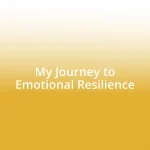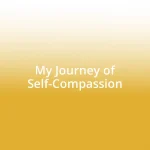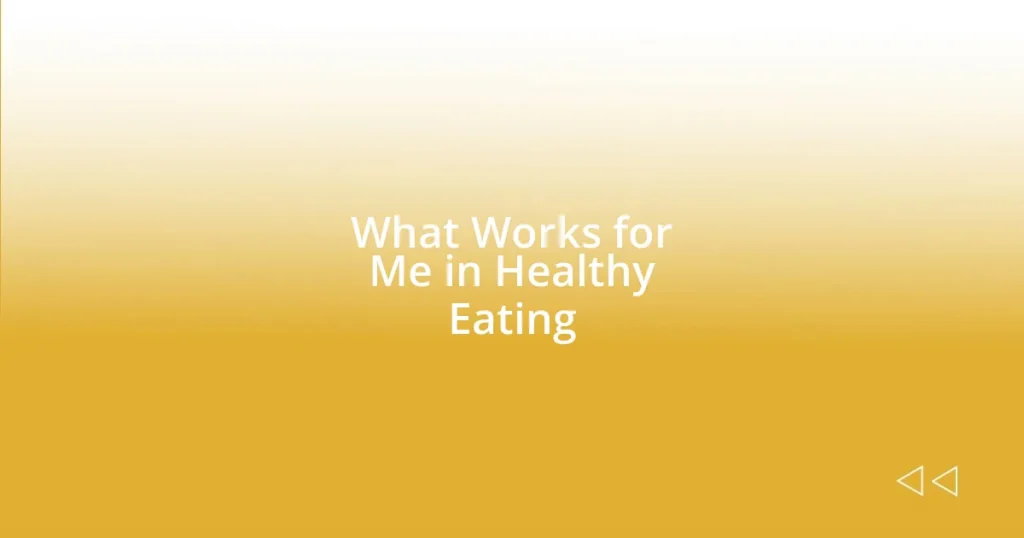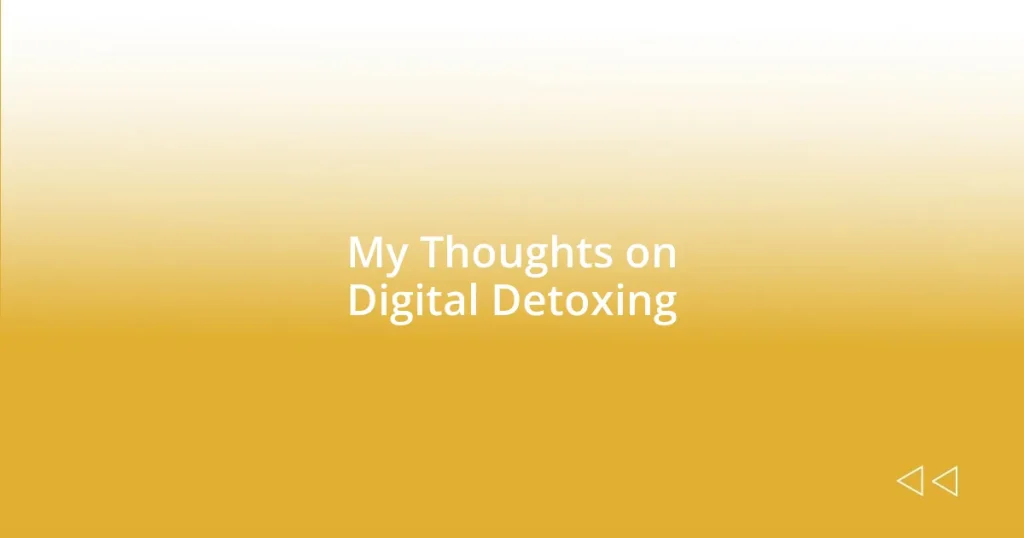Key takeaways:
- Meditation can transform one’s relationship with stress by providing clarity and enabling a calm response to overwhelming situations.
- Scientific research shows that regular meditation reduces cortisol levels, enhances focus, and improves emotional regulation.
- Incorporating mindfulness into daily activities can create moments of serenity and change dynamics in challenging situations.
- Consistent meditation practice leads to long-term benefits, including enhanced emotional resilience and improved focus and clarity.

Understanding Stress and Meditation
Stress often feels like an unstoppable force in our lives, doesn’t it? I remember a period when I was juggling work deadlines and personal commitments, and it felt like I was drowning. That’s when I discovered meditation—a practice that shifted not just my perspective on stress but my entire approach to life.
As I began to meditate, I realized that my stress was often rooted in my thoughts and reactions rather than my circumstances. One afternoon, while sitting quietly, I was struck by the clarity that arose from simply observing my thoughts without judgment. This realization was transformative; it was like taking a step back and seeing the bigger picture, where stress didn’t have to be the main character.
Meditation taught me that stress is a natural response, but how we engage with it can make all the difference. Have you ever noticed how just a few deep breaths can change your mindset? I now find that creating space for stillness allows me to respond to stress rather than react impulsively, giving me a sense of control that’s both soothing and empowering.

The Science Behind Meditation
The science behind meditation reveals fascinating insights into how this practice impacts our brains and bodies. Always curious about the effects of my meditative practice, I found that research shows that regular meditation can alter brain structure. Studies indicate increased grey matter density in areas of the brain associated with emotional regulation and stress response, reinforcing my sense of calm and clarity during challenging moments.
Here are some key findings that highlight the science behind meditation:
- Reduced Cortisol Levels: Meditation can significantly lower cortisol, the hormone associated with stress, which I noticed especially after long sessions of mindfulness.
- Increased Focus: Research indicates that meditation enhances attention and concentration, helping me stay present rather than spiraling into anxiety.
- Emotional Regulation: Neuroimaging studies show that meditators have stronger connections in the prefrontal cortex, leading to better emotional control, which I’ve personally experienced during hectic weeks.
- Improvement in Well-being: Regular practice is linked to heightened levels of happiness and life satisfaction, demonstrating how a few minutes of focused breathing positively affects my overall mood.
The interplay between meditation and stress relief feels deeply rooted in this scientific evidence, prompting me to explore various techniques that work best for me.

Personal Journey with Meditation
Meditation became a vital part of my life during a particularly chaotic time. I remember feeling overwhelmed, almost as if my thoughts were a never-ending storm. It was during one quiet evening, sitting cross-legged on my living room floor, that I realized I had the power to weather this storm. Each breath I took grounded me, reminding me that I could find peace amid the chaos, shifting my relationship with stress into something manageable.
One memorable moment during my practice involved an intense week at work. I had a looming deadline and felt the familiar grip of anxiety tightening around me. Instead of diving headfirst into panic, I decided to sit down and meditate for just ten minutes. That short session helped me peel away layers of tension, allowing me to return to my tasks with a clearer mind and a renewed sense of purpose. It’s incredible how a few minutes can redefine a hectic day into one of clarity and focus.
Now, I view meditation not just as a tool for managing stress, but as a refuge. It teaches me to embrace stillness and find comfort in solitude. There’s a profound sense of empowerment in knowing that I can orchestrate my emotional responses. When the stresses of life rise up, I gently remind myself that I can always retreat into my practice, creating an inner sanctuary that keeps me grounded.
| Key Insights | Personal Reflections |
|---|---|
| Meditation provides a refuge from stress. | It’s where I rediscover my inner peace. |
| Each session offers a chance to reset my mind. | After a busy day, it’s my way of finding balance. |
| I’ve learned to let thoughts pass by. | It feels empowering to observe without judgment. |

Techniques for Effective Stress Relief
When it comes to effective stress relief, I’ve found that incorporating breathwork techniques can truly transform my day. For instance, I’ve adopted the 4-7-8 breathing technique, where I inhale for four seconds, hold for seven, and exhale for eight. This simple practice always grounds me, helping me shift from a state of stress to one of calmness, almost like hitting a reset button when life gets too hectic.
Another technique that stands out for me is progressive muscle relaxation (PMR). I remember a particularly stressful situation before a big presentation. As I sat alone, my shoulders felt as if they were carrying the weight of the world. I took a moment to tense and then relax each muscle group—starting from my toes and moving upwards. The tangible release of tension was immediate and enlightening. It was as if I could physically let go of my stress, and I walked into that presentation feeling empowered rather than overwhelmed.
Art and journaling have also become invaluable tools in my stress management toolkit. I often grab my sketchbook to doodle during a tough day; I find that drawing my thoughts allows me to process emotions visually. Similarly, when I take a moment to jot down my thoughts, I explore questions like, “What can I learn from this stress?” This act of acknowledgment empowers me to gain clarity, often transforming my anxious feelings into opportunities for growth. Isn’t it fascinating how expressing ourselves can turn a chaotic mind into a landscape of possibilities?

Incorporating Mindfulness into Daily Life
Incorporating mindfulness into daily life isn’t as daunting as it sounds. I started small, perhaps while waiting for my coffee to brew or during a lunch break. Just a few moments of focused breathing transformed these mundane tasks into opportunities for mindfulness. Have you ever noticed how much richer a moment can feel when you simply pause and breathe? It’s like a recalibration of the mind, redirecting it from stress to presence.
One day, as I walked my dog, I decided to engage fully with my surroundings instead of letting my thoughts wander. I noticed the rustling leaves, the scent of fresh grass, and even the rhythm of my dog’s tail wagging in happiness. This simple act of being present brought a sense of joy I hadn’t anticipated. It made me realize that mindfulness could be weaved into routine activities, creating moments of serenity throughout the day. What if you integrated mindfulness into something you already do regularly?
Even when faced with challenges, mindfulness can be your shield. I recall a frustrating moment during a family dinner, where disagreements were brewing. Instead of reacting impulsively, I took a deep breath and focused on my sensations, allowing emotions to pass through without judgment. This conscious pause not only diffused tension but also fostered a more meaningful dialogue. It’s incredible how a little mindfulness can change the dynamic of a situation, isn’t it?

Building a Consistent Meditation Practice
Building a consistent meditation practice can feel like climbing a mountain at first, but honestly, it becomes easier with each step. Early on, I struggled to find the right time and space. I remember setting my alarm fifteen minutes earlier just to create that quiet moment alone in the morning. The first few days felt awkward, but soon, my body yearned for that stillness, and I began to look forward to my little sanctuary of peace.
One strategy that has worked wonders for me is creating a dedicated space for meditation. I transformed a small corner of my room into a calming oasis with soft pillows, a cozy blanket, and even a few candles. This space became my retreat, and I found that when I entered it, my mind would automatically shift gears into a more tranquil state. Isn’t it interesting how our environment can influence our mindset? Each time I settled in there, I could feel the stress of the day dissipating like mist in the morning sun.
Establishing a consistent routine also plays a crucial role in my practice. At one point, I committed to meditating after my morning coffee, making it a non-negotiable part of my day. This consistency helped anchor my habit, and my body became conditioned to expect that moment of reflection. Have you ever noticed how regularity can bring a sense of comfort? It’s like knowing that each day, regardless of how chaotic life gets, there’s a moment dedicated solely to reconnecting with myself.

Long Term Benefits of Meditation
Meditation has this incredible way of impacting not just the present moment, but also the long-term state of our minds. I’ve found that after months of consistent practice, my ability to handle stress improved significantly. Instead of spiraling in the face of challenges, I now find myself pausing, evaluating situations with a clearer mindset. Isn’t it remarkable how a simple habit can rewire our brain’s response to stress?
One long-term benefit I cherish is enhanced emotional resilience. There was a time when I would react impulsively to criticism, feeling defensive and upset. However, through meditation, I learned to observe my emotions without getting swept away by them. This shift has allowed me to respond thoughtfully, leading to healthier relationships and a more peace-filled life. How could cultivating this resilience change the dynamics in your interactions?
Additionally, I’ve noticed that my focus and clarity have improved over time. When I first began meditating, my thoughts raced like a formula one car, making it hard to concentrate. Now, even during a hectic workday, I can zone in on tasks without the nagging distractions that once consumed me. Isn’t it empowering to realize that with practice, we can sharpen our minds and enhance our productivity? The long-term benefits of meditation extend far beyond moments of calm; they seep into every facet of our lives.















